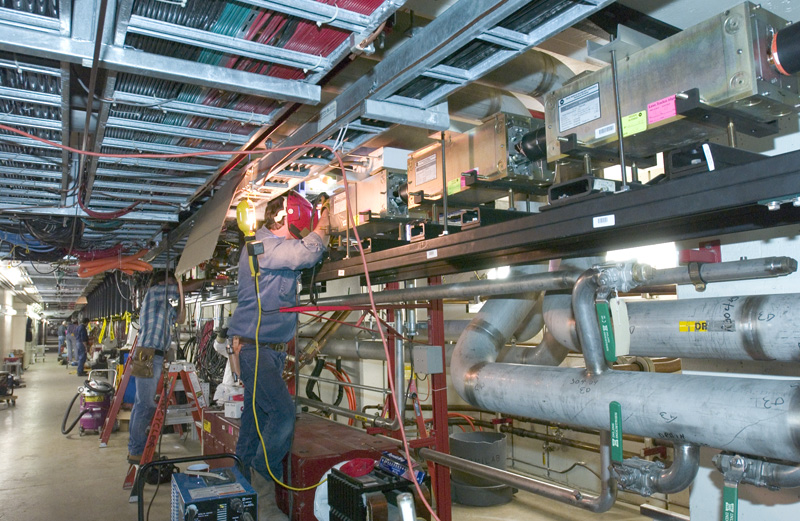The Fermilab accelerator complex

Fermilab's accelerator complex comprises ten particle accelerators and storage rings. It produces the world's most powerful, high-energy neutrino beam and provides proton and neutron beams for various experiments, R&D programs as well as cancer treatment.
In 2012, Fermilab will upgrade its accelerator complex to double the beam intensity of its high-energy neutrino beam and to provide optimal beam for a broad range of new and existing experiments at the Intensity Frontier.
Fermilab pursues an active accelerator R&D program, collaborating with industry, universities and laboratories around the world. The laboratory operates a superconducting test accelerator and is developing plans to build a new, half-mile-long proton accelerator, Project X, on the Fermilab site.
| Fermilab accelerator | Size/energy | Plans for the future |
|---|---|---|
Cockcroft Walton pre-accelerator
|
Fills a space about the size of a large living room with high ceilings; accelerates particles to 750,000 electron volts (750 keV) | Provides the particles for the Linear Accelerator and the rest of Fermilab’s chain of accelerators; Will be replaced with a more efficient particle source in 2012 |
Linear Accelerator
|
About 500 feet long; accelerates particles to 400,000,000 eV (400 MeV) or about 70 percent of the speed of light | Provides neutron beam for cancer treatment; Provides proton beam for the MuCool test area, which is used to develop accelerator components for a future muon collider Provides proton beam for the Booster accelerator and the rest of the chain of accelerators |
Booster
|
About 1,500 feet in circumference; accelerates particles to 8,000,000,000 eV (8 GeV) |
Provides low-energy neutrino beam for the MiniBooNE experiment and, in late 2013, the MicroBooNE experiment Provides proton beam for the Main Injector accelerator |
Main Injector
|
About 2 miles in circumference; accelerates particles up to 150 GeV, or more than 99 percent of the speed of light | Creates world’s highest-intensity neutrino beam; Will be upgraded in 2012 to double the number of neutrinos produced; Provides beam for the following neutrino experiments: MINOS, Minerva and, beginning in 2013, NOvA; a fourth neutrino experiment, LBNE, is in planning; Provides low-intensity particle beams for testing of detector technologies; Will provide proton beam to the SeaQuest fixed-target experiment; |
Recycler
|
About 2 miles in circumference; stores particles at 8 GeV | Stored antiprotons prior to injection into the Tevatron; In the future, will be used to store protons to make operations of Main Injector accelerator more efficient |
Electron cooling
|
Used a 25-foot-high Pelletron to accelerate electrons to 3.5 MeV so that they have the same speed as 8 GeV antiprotons | Cooled antiprotons by surrounding them with electrons traveling at same speed to create narrower, more dense antiproton beam for the Tevatron; no immediate use after the Tevatron shutdown; |
Antiproton Source
|
About 1,600 feet in circumference | Produced antiprotons for the Tevatron; Will be modified to provide muons for the Muon g-2 experiment and later will support the Mu2e experiment |
Tevatron
|
About 6 kilometers in circumference; accelerated particles to 1,000,000,000,000 eV (1 TeV) | Created world’s highest-energy proton-antiproton collisions for the CDF and DZero experiments; proposals exist to reuse parts of the accelerator and its tunnel for educational tours or new experiments; |
SRF Test Accelerator
|
When complete, about 460 feet long; will accelerate electrons up to 1.5 GeV | Gives scientists the opportunity to test superconducting radio-frequency acceleration technologies, which is the technology of choice for future high-energy accelerators; Construction is under way to expand the test accelerator and to build up to five test stations and one electron ring for studies involving electron beams |
Photo Injector
|
About 50 feet long; uses UV laser to knock electrons out of a metal and accelerates them to 16 MeV | Helped develop efficient particle sources for future accelerators; Will be dismantled and parts will be reused for a particle source at the SRF Test Accelerator; Some components will be moved to the new Illinois Accelerator Research Center |
Proposed: Project X
|
Proposed to be about half a mile long; would accelerate particles to 3 GeV and then 8 GeV |
Proposed to create the world’s highest-intensity proton beam, with more particles more densely packed than in any other accelerator in the world; Groundbreaking could occur in 2015 or later Would provide 3-GeV beam for kaon, muon and nuclei experiments Would provide 8-GeV beam to the Main Injector accelerator and the related research programs, replacing the 40-year-old Linear and Booster accelerators |
In addition to accelerator-based research, Fermilab carries out a broad range of particle astrophysics experiments, including research on cosmic rays, dark matter and dark energy.




